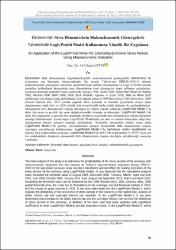Ekonominin stres dönemlerinin makroekonomik göstergelerle tahmininde logit/probit model kullanımına yönelik bir uygulama
Citation
Çetin, A. C. (2023). Ekonominin Stres Dönemlerinin Makroekonomik Göstergelerle Tahmininde Logit/Probit Model Kullanımına Yönelik Bir Uygulama . Afyon Kocatepe Üniversitesi Sosyal Bilimler Dergisi , 25 (1) , 88-104 . DOI: 10.32709/akusosbil.883343Abstract
Ekonominin stres dönemlerinin öngörülebilirliğinin makroekonomik göstergelerle belirlenmesi bu
çalışmanın ana konusunu oluşturmaktadır. Bu amaçla Türkiye’nin 1996:01-2020:10 dönemi
makroekonomik göstergeleri üzerinden spekülatif baskı endeksi oluşturulmuş ve Logit ve Probit olasılık
modelleri kullanılarak ekonominin stres dönemlerinin öncü göstergeleri tespit edilmeye çalışılmıştır.
İncelenen dönemde spekülatif baskı endeksinin Ağustos 1998, Aralık 2000, Şubat-Mart-Nisan ve Haziran
2001, Haziran 2006, Ekim 2008, Ocak 2014, Haziran, Ağustos ve Eylül 2018, Mart ve Nisan 2020
tarihlerinde eşik değeri aştığı görülmüştür. Eşik değerin aşılması 1998 Rusya krizi, 2001 döviz krizi, 2008
küresel finansal kriz, 2018 yılında yaşanan döviz kurunda ve finansal piyasalarda ortaya çıkan
dalgalanmaya bağlı kriz ve 2020 yılında brüt rezervlerdeki azalış yönlü değişme ile açıklanabilmiştir.
Ekonominin stres dönemlerinin oluşma olasılığını en yüksek oranda açıklayan Logit/Probit Model-1’in
dolar faiz oranı ve gecelik faiz oranı değişkenlerinden oluştuğu belirlenmiştir. Logit/Probit Model-1’de
dolar faiz oranındaki ve gecelik faiz oranındaki artışların ekonomide stres dönemlerinin oluşma ihtimalini
artırdığı belirlenmiştir. Ayrıca diğer Logit/Probit Modellerde yer alan ve anlamlı katsayılara sahip bazı
değişkenlerin önemli sonuçlar sunduğu görülmüştür. Güvenirlik bakımından yüksek orana sahip
Logit/Probit Model-2’de portföy yatırımlarındaki azalışın ekonominin stres dönemlerinin oluşma
olasılığını artırabileceği belirlenmiştir. Logit/Probit Model-3’de bankalarca verilen kredilerdeki ve
tüketici fiyat endeksindeki artışların, Logit/Probit Model-4’de BIST100 endeksindeki ve TÜFE bazlı reel
kur endeksindeki düşüşlerin ekonomide stres dönemlerinin oluşma olasılığını artırabileceği sonucuna
varılmıştır. The main subject of this study is to determine the predictability of the stress periods of the economy with
macroeconomic indicators. For this purpose on Turkey’s macroeconomic indicators during 1996:01-
2020:10 the speculative pressure index has been established and identified the leading indicators of the
stress periods of the economy using Logit/Probit models. It was observed that the speculative pressure
index exceeded the threshold value in August 1998, December 2000, February, March, April and June
2001, June 2006, October 2008, January 2014, June, August and September 2018, March and April 2020.
Exceeding the threshold value can be explained by the 1998 Russian crisis, 2001 currency crisis, 2008
global financial crisis, the crisis due to fluctuations in the exchange rate and financial markets in 2018,
and the change in gross reserves in 2020. It has been determined that the Logit/Probit Model-1, which
explains the probability of the occurrence of stress periods in the economy at the highest rate, consists of
dollar interest rate and overnight interest rate variables. In the Logit/Probit Model-1, it has been
determined that increases in the dollar interest rate and the overnight interest rate increase the likelihood
of stress periods in the economy. In addition, it has been seen that some variables with significant
coefficients in other Logit/Probit Models provide important results. In the Logit/Probit Model-2, which has a high rate of reliability, it has been determined that the decrease in portfolio investments may
increase the probability of occurrence of stress periods in the economy. It was concluded that the
increases in loans given by banks and consumer price index in Logit/Probit Model-3, decreases in
BIST100 index and CPI-based real exchange rate index in Logit/Probit Model-4 may increase the
probability of occurrence of stress periods in the economy.
Source
Sosyal Bilimler DergisiVolume
25Issue
1Collections
- Cilt 25 : Sayı 1 [25]



















